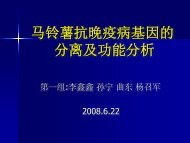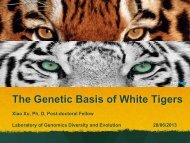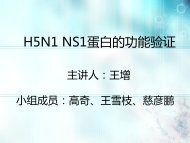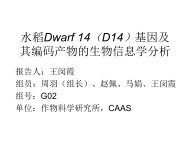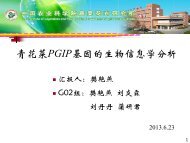Environmental connections of novel avian-origin H7N9 influenza ...
Environmental connections of novel avian-origin H7N9 influenza ...
Environmental connections of novel avian-origin H7N9 influenza ...
You also want an ePaper? Increase the reach of your titles
YUMPU automatically turns print PDFs into web optimized ePapers that Google loves.
6 Li J, et al. Sci China Life Sci June (2013) Vol.56 No.6Figure 3 Chromatogram <strong>of</strong> the HA sequences flanking the amino acids atposition 226. The dashed boxes show the nonsynonymous substitutions.The 226I substitution in the HA <strong>of</strong> Hangzhou/1 is compared with the 226Lin the other three viruses.in the newly-emerging <strong>H7N9</strong> virus.3 DiscussionWe described three infected cases in Hangzhou City andidentified the <strong>novel</strong> reassortant <strong>influenza</strong> A (<strong>H7N9</strong>) virusesin the respiratory specimens from these patients, as well asfrom environmental samples. Hangzhou City is close toShanghai Municipality, where the first <strong>influenza</strong> A (<strong>H7N9</strong>)virus infections were reported [1]. Although later than thecases in Shanghai Municipality, the onset <strong>of</strong> the illness <strong>of</strong>two <strong>of</strong> the patients described here was reported around thesame time as the illness <strong>of</strong> the patient in Anhui Province.Two <strong>of</strong> the three patients had a history <strong>of</strong> direct contact withlive poultry or with local free markets. A closely related<strong>H7N9</strong> virus was identified in the contacted environment <strong>of</strong>Patient 2. These data may provide direct evidence for thelinking, or even transmission, <strong>of</strong> the <strong>avian</strong> <strong>H7N9</strong> viruses tohumans in these adjacent provinces <strong>of</strong> east China.Although the clinical characteristics <strong>of</strong> the three casesreported here are very similar to the early cases reportedpreviously in Anhui and Shanghai, namely high fever andsevere respiratory symptoms, the genetic diversity <strong>of</strong> thegenomes <strong>of</strong> the new Hangzhou <strong>H7N9</strong> viruses was determined.The H7 phylogenetic trees placed the Hangzhou/1,Hangzhou/2 and Hangzhou/3 viruses on separate branches.Within the HA, NA and PB2 sequences from all the publiclyavailable <strong>H7N9</strong> viruses, we identified 36 sites with atleast one amino acid mutation (Table 2). These data mayindicate the independent and rapid evolution <strong>of</strong> the virusesin the natural reservoir and their independent introduction tohuman. However, based on the currently available <strong>H7N9</strong>virus sequences, we found a series <strong>of</strong> other substitutions themajority <strong>of</strong> which were synonymous mutations (Table S2).The effects <strong>of</strong> these substitutions on the fitness <strong>of</strong> the virus-Figure 4 Map <strong>of</strong> China showing the substitutions in the host-signatures from the different virus sequences. The provinces and municipal cities with reported<strong>H7N9</strong> cases are in brown. The features <strong>of</strong> each <strong>of</strong> the sites are shown as follows: Province (number <strong>of</strong> human cases+number <strong>of</strong> environment/poultrycases), Gene (amino acid position): Residue (human); Residue (environment/poultry). Residues with <strong>avian</strong>-signatures are in purple; residues with mammalsignaturesare in yellow. The 226I in the HA from A/Hangzhou/1/2013 is highlighted in red.




